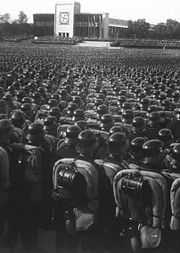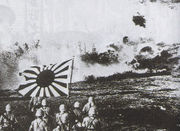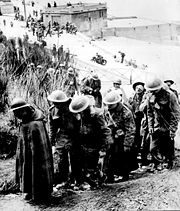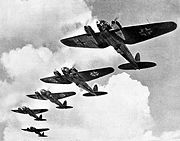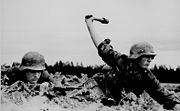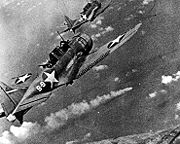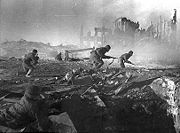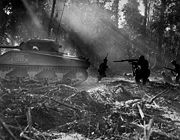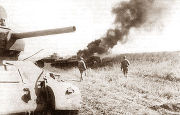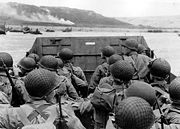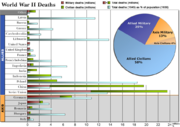World War II
2008/9 Schools Wikipedia Selection. Related subjects: British History Post 1900; World War II
| World War II | |||||||
|---|---|---|---|---|---|---|---|
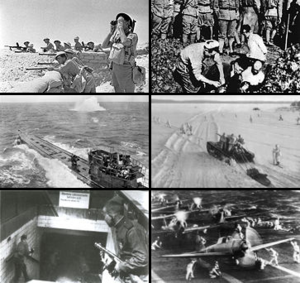 Clockwise from top left: Commonwealth troops in the desert; Chinese civilians being buried alive by Japanese soldiers; Soviet forces during a winter offensive; Carrier-borne Japanese planes readying for take off; Soviet troops fighting in Berlin; A German submarine under attack. |
|||||||
|
|||||||
| Belligerents | |||||||
| Allies | Axis powers | ||||||
| Commanders | |||||||
| Allied leaders | Axis leaders | ||||||
| Casualties and losses | |||||||
| Military dead: Over 14,000,000 Civilian dead: Over 36,000,000 Total dead: Over 50,000,000 ...further details. |
Military dead: Over 8,000,000 Civilian dead: Over 4,000,000 Total dead Over 12,000,000 ...further details. |
||||||
|
|||||
World War II, or the Second World War, was a global military conflict, the joining of what had initially been two separate conflicts. The first began in Asia in 1937 as the Second Sino-Japanese War; the other began in Europe in 1939 with the German invasion of Poland.
This global conflict split the majority of the world's nations into two opposing military alliances: the Allies and the Axis powers. It involved the mobilization of over 100 million military personnel, making it the most widespread war in history, and placed the participants in a state of " total war", erasing the distinction between civil and military resources. This resulted in the complete activation of a nation's economic, industrial, and scientific capabilities for the purposes of the war effort. Over 60 million people, the majority of them civilians, were killed, making it the deadliest conflict in human history. The financial cost of the war is estimated at about a trillion 1944 U.S. dollars worldwide, making it the most costly war in capital as well as lives.
The Allies were victorious, and, as a result, the United States and Soviet Union emerged as the world's two leading superpowers. This set the stage for the Cold War, which lasted for the next 45 years. The United Nations was formed in hopes of preventing another such conflict. The self determination spawned by the war accelerated decolonization movements in Asia and Africa, while Europe itself began moving toward integration.
Background
In the aftermath of World War I, the defeated German Empire was made to sign the Treaty of Versailles. This restricted German military and territorial growth and required the payment of massive war reparations. Civil war in Russia led to the creation of the communist Soviet Union which soon fell under the control of Joseph Stalin. In Italy, Benito Mussolini seized power as a fascist dictator promising to create a " New Roman Empire". The ruling Kuomintang party in China launched a unification campaign against rebelling warlords in the mid-1920s, but was soon embroiled in a civil war against its former Chinese communist allies. In 1931, an increasingly militaristic Japanese Empire, which had long sought influence in China as the first step of its right to rule Asia, used the Mukden Incident as justification to invade Manchuria; the two nations then fought several small conflicts until the Tanggu Truce in 1933.
In 1933, National Socialist Adolf Hitler became the leader of Germany and began a massive rearming campaign. This worried France and the United Kingdom, who had lost much in the previous war, as well as Italy, which saw its territorial ambitions threatened by those of Germany. To secure its alliance, the French allowed Italy a free hand in Ethiopia, which Italy desired to conquer. The situation was aggravated in early 1935 when the Saarland was legally reunited with Germany and Hitler repudiated the Treaty of Versailles, speeding up remilitarization and introducing conscription. Hoping to contain Germany, the United Kingdom, France and Italy formed the Stresa Front. The Soviet Union, also concerned due to Germany's goals of capturing vast areas of eastern Europe, concluded a treaty of mutual assistance with France.
These alliances did not amount to much. The Franco-Soviet pact, required to go through the League of Nations bureaucracy before taking effect, was essentially toothless and in June of 1935, the United Kingdom made an independent naval agreement with Germany easing prior restrictions. The isolationist United States, concerned with events in Europe and Asia, passed the Neutrality Act in August. In October Italy invaded Ethiopia, but was soon politically isolated, with Germany the only major European nation supporting its aggression. Alliances shifted, with Italy revoking its objections to Germany's goal of making Austria a satellite state.
In March of 1936, Hitler remilitarized the Rhineland in direct violation of the Versailles and Locarno treaties, receiving little response from other European powers. When the Spanish Civil War broke out in July, Hitler and Mussolini supported fascist Generalísimo Francisco Franco in his civil war against the Soviet-supported Spanish Republic. Both sides used the conflict to test new weapons and methods of warfare.
With tensions mounting, efforts to strengthen or consolidate power were made. In October, Germany and Italy formed the Rome-Berlin Axis and a month later Germany and Japan, each believing communism–and the Soviet Union in particular–to be a threat, signed the Anti-Comintern Pact, which Italy would join in the following year. In China, the Kuomintang and communist forces agreed on a ceasefire to present a united front to oppose Japan.
Course of the war
War breaks out
In mid-1937, following the Marco Polo Bridge Incident, Japan began a full invasion of China. The Soviets quickly lent support to China, effectively ending China's prior cooperation with Germany. Starting at Shanghai, the Japanese pushed Chinese forces back, capturing the capital Nanjing in December. In June of 1938 Chinese forces stalled the Japanese advance by flooding the Yellow River. Though this bought time to prepare their defenses at Wuhan, the city was still taken by October. During this time, Japanese and Soviet forces engaged in a minor skirmish at Lake Khasan; in May of 1939, they became involved in a more serious border war.
In Europe, Germany and Italy were becoming bolder. In March 1938, Germany annexed Austria, again provoking little response from other European powers. Encouraged, Hitler began making claims on the Sudetenland; France and Britain conceded these for a promise of no further territorial demands. Germany soon reneged, and in March 1939 fully occupied Czechoslovakia.
Alarmed, and with Hitler making further demands on Danzig, France and Britain guaranteed their support for Polish independence; when Italy conquered Albania in April, the same guarantee was extended to Romania and Greece. The Soviet Union also attempted to ally with France and Britain, but was rebuffed due to western suspicions about Soviet motives and capability. Shortly after the Franco-British pledges to Poland, Germany and Italy formalized their own alliance with the Pact of Steel; following this, in a move that shocked all other major powers, Germany and the Soviet Union concluded a non-aggression pact, including a secret agreement to split Poland and eastern Europe between them.
By the start of September the Soviets had routed Japanese forces and the Germans invaded Poland. France, Britain and the Commonwealth declared war on Germany but lent little support other than a small French attack into the Saarland. In mid-September, after signing an armistice with Japan, the Soviets launched their own invasion of Poland. By early October, Poland had been divided between Germany and the Soviet Union. During the battle in Poland, Japan launched its first attack against Changsha, a strategically important Chinese city, but was repulsed by early October.
Axis advances
Following the invasion of Poland, the Soviets began moving troops into the Baltic region. Finnish resistance in late November led to a four-month war, ending with Finnish concessions. France and the United Kingdom, treating the Soviet attack on Finland as tantamount to entering the war on the side of the Germans responded to the Soviet invasion by supporting its expulsion from the League of Nations. Though China had the authority to veto such an action, it was unwilling to alienate itself from either the Western powers or the Soviet Union and instead abstained. The Soviet Union was displeased by this course of action and as a result suspended all military aid to China. By mid-1940, the Soviet Union's occupation of the Baltics was completed with the installation of pro-Soviet governments.
In Western Europe, British troops deployed to the Continent but neither Germany nor the Allies launched direct attacks on the other. In April, Germany invaded Denmark and Norway to secure shipments of iron-ore from Sweden which the allies would try to disrupt. Denmark immediately capitulated, and despite Allied support Norway was conquered within two months. British discontent over the Norwegian campaign led to the replacement of Prime Minister Neville Chamberlain by Winston Churchill on May 10th.
On that same day, Germany invaded France and the Low Countries, making rapid progress using blitzkrieg tactics. By the end of the month the Netherlands and Belgium had been overrun and British troops were forced to evacuate the continent, abandoning their heavy equipment. On June 10th, Italy invaded, declaring war on both France and the United Kingdom; twelve days later France surrendered and was soon divided into German and Italian occupation zones, and an unoccupied rump state under the Vichy Regime. In early July, the British attacked the French fleet in Algeria to prevent their seizure by Germany.
With France neutralized, the Axis was emboldened. Germany began an air superiority campaign over Britain to prepare for an invasion and enjoyed success against an over-extended Royal Navy, using U-boats against British shipping in the Atlantic. Italy began operations in the Mediterranean, initiating a siege of Malta in June, conquering British Somaliland in August, and making an incursion into British-held Egypt in early September. Japan increased its blockade of China in September by seizing several bases in the northern part of the now-isolated French Indochina.
Throughout this period, the neutral United States took measures to assist China and the Western Allies. In November 1939, the American Neutrality Act was amended to allow Cash and carry purchases by the Allies. During 1940, the United States implemented a series of embargos, including oil, iron, steel and mechanical parts, against Japan; in September it agreed to a trade of American destroyers for British bases.
At the end of September the Tripartite Pact between Japan, Italy and Germany formalized the Axis Powers. As a warning to the United States, the pact stipulated that, with the exception of the Soviet Union, any country not currently in the war which attacked any Axis Power would be forced to go to war against all three. The Soviet Union expressed interest in joining the Tripartite Pact, sending a modified draft to Germany in November and offering a very German-favourable economic deal; while Germany remained silent on the former, they accepted the latter. Regardless of the pact, the United States continued to support the United Kingdom and China by introducing the Lend-Lease policy and creating a security zone spanning roughly half of the Atlantic Ocean where the United States Navy protected British convoys.
Soon after the pact, Italy's fortunes changed. In October, Italy invaded Greece but within days were repulsed and pushed back into Albania, where a stalemate soon occurred. Shortly after this, in Africa, Commonwealth forces launched offensives against Libya and Italian East Africa. By early 1941, with Italian forces having been pushed back into Libya by the Commonwealth, Churchill ordered a dispatch of troops from Africa to bolster the Greeks. The Italian Navy also suffered significant defeats, with the Royal Navy putting three Italian battleships out of commission via carrier attack at Taranto, and several more warships neutralized at Cape Matapan.
The Germans soon intervened to assist Italy. Hitler sent German forces to Libya in February and by the end of March they had launched an offensive against the diminished Commonwealth forces. In under a month, Commonwealth forces were pushed back into Egypt with the exception of the besieged port of Tobruk. The Commonwealth attempted to dislodge Axis forces in May and again in June, but failed on both occasions. In early April the Germans similarly intervened in the Balkans, invading Greece and Yugoslavia; here too they made rapid progress, eventually forcing the Allies to evacuate after Germany conquered the Greek island of Crete by the end of May.
The Allies did have some successes during this time though. In the Middle East, Commonwealth forces first quashed a coup in Iraq which had been supported by German aircraft from bases within Vichy-controlled Syria, then, with the assistance of the Free French, invaded Syria and Lebanon to prevent further such occurrences. In the Atlantic, the British scored a much needed public morale boost by sinking the German flagship Bismarck. Perhaps most importantly, the Royal Air Force had successfully resisted the Luftwaffe's assault, and on May 11, 1941, Hitler called off the bombing campaign over Britain.
In Asia, in spite of several offensives by both sides, the war between China and Japan was stalemated by 1940. In August of that year, Chinese communists launched an offensive in Central China; in retaliation, Japan instituted harsh measures in occupied areas to reduce human and material resources for the communists. Mounting tensions between Chinese communist and nationalist forces culminated in January 1941, effectively ending their co-operation.
With the situation in Europe and Asia relatively stable, Germany, Japan and the Soviet Union made preparations. With the Soviets weary of mounting tensions with Germany and the Japanese planning to take advantage of the European War by seizing resource-rich European possessions in Southeast Asia the two powers signed a neutrality agreement in April, 1941. By contrast the Germans were steadily making preparations for an attack on the Soviet Union, amassing forces on the Soviet border, particularly in Finland and Romania.
The war becomes global
In late June, Germany, along with other European Axis members and Finland, invaded the Soviet Union. They made significant gains into Soviet territory, a inflicting large numbers of casualties, and by the start of December had almost reached Moscow, with only the besieged cities of Leningrad and Sevastopol behind their front-lines left unconquered. With the onset of a fierce Soviet winter though, the Axis offensive was ground to a halt and the Soviets launched a counter-offensive using reserve troops brought up from the border near Japanese Manchukuo.
Following the German attack on the Soviets, the United Kingdom began to regroup. In July, the United Kingdom and the Soviet Union formed a military alliance against Germany and shortly after jointly invaded Iran to secure the Persian Corridor and Iran's oilfields. In August, the United Kingdom and United States jointly issued the Atlantic Charter, a vision for a post-war world which included "the right of all peoples to choose their form of government". In November, Commonwealth forces launched a counter-offensive in the desert, reclaiming all gains the Germans and Italians had made.
In Asia, Japan was preparing for war. The Imperial General Headquarters plan was to create a large perimeter stretching into the Central Pacific in order to facilitate a defensive war while exploiting the resources of Southeast Asia; to prevent intervention while securing the perimeter it was further planned to neutralize the United States Pacific Fleet on the outset. In preparation, Japan seized military control of southern Indochina in July, 1941; an action the United States, United Kingdom and other western governments responded to by freezing all Japanese assets. On December 7th Japan attacked British, Dutch and American holdings with near simultaneous offensives against Southeast Asia and the Central Pacific, including an attack on the American naval base of Pearl Harbour.
These actions prompted the United States, United Kingdom, China, and other Western Allies to declare war on Japan. Italy, Germany, and the other members of the Tripartite Pact responded by declaring war on the United States. In January, the United States, United Kingdom, Soviet Union and China, along with twenty-two smaller or exiled governments, issued the Declaration by United Nations, affirming the Atlantic Charter and formalizing their alliance against the Axis Powers. The Soviet Union did not adhere fully to the declaration though, as they maintained their neutrality agreement with Japan and exempted themselves from the principle of self-determination.
The Axis Powers, however, were able to continue their offensives. Japan had almost fully conquered Southeast Asia with minimal losses by the end of April, 1942, chasing the Allies out of Burma and taking large numbers of prisoners in the Philippines, Malaya, Dutch East Indies and Singapore. They further bombed the Allied naval base at Darwin, Australia and sunk significant Allied warships not only at Pearl Harbour, but also in the South China Sea, Java Sea and Indian Ocean. The only real successes against Japan were a repulsion of their renewed attack on Changsha in early January, 1942, and a psychological strike from a bombing raid on Japan's capital Tokyo in April.
Germany was able to regain the initiative as well. Exploiting American inexperience with submarine warfare, the German Navy sunk significant resources near the American Atlantic coast. In the desert, they launched an offensive in January, pushing the British back to positions at the Gazala Line by early February. In the Soviet Union, the Soviet's winter counter-offensive had ended by March. In both the desert and the Soviet Union, there followed a temporary lull in combat which Germany used to prepare for their upcoming offensives.
The tide turns
In early May, Japan initiated operations to capture Port Moresby via amphibious assault and thus sever the line of communications between the United States and Australia. The Allies, however, intercepted and turned back Japanese naval forces, preventing the invasion. Japan's next plan, motivated by the earlier bombing on Tokyo, was to seize the Midway Atoll as this would seal a gap in their perimeter defenses, provide a forward base for further operations, and lure American carriers into battle to be eliminated; as a diversion, Japan would also send forces to occupy the Aleutian Islands. In early June, Japan put their operations into action but the Americans, having broken Japanese naval codes in late May, were fully aware of the Japanese plans and force dispositions and used this knowledge to achieve a decisive victory over the Imperial Japanese Navy. With their capacity for amphibious assault greatly diminished as a result of the Midway battle, Japan chose to focus on an overland campaign on the Territory of Papua in another attempt to capture Port Moresby. For the Americans, they planned their next move against Japanese positions in the southern Solomon Islands, primarily against the island of Guadalcanal, as a first step towards capturing Rabaul, the primary Japanese base in Southeast Asia. Both plans started in July, but by mid-September the battle for Guadalcanal took priority for the Japanese, and troops in New Guinea were ordered to withdraw from the Port Moresby area to the northern part of the island. Guadalcanal soon became a focal point for both sides with heavy commitments of troops and ships in a battle of attrition. By the start of 1943, the Japanese were defeated on the island and withdrew their troops.
In Burma, Commonwealth forces mounted two operations. The first, an offensive into the Arakan region in late 1942 went disastrously, forcing a retreat back to India by May of 1943. The second was the insertion of irregular forces behind Japanese front-lines in February which, by the end of April, had achieved dubious results.
On the German's eastern front, they defeated Soviet offensives in the Kerch Peninsula and at Kharkov and then launched their main summer offensive against southern Russia in June, 1942, to seize the oil fields of the Caucasus. The Soviets decided to make their stand at Stalingrad which was in the path of the advancing German armies and by mid-November the Germans had nearly taken Stalingrad in bitter street fighting when the Soviets began their second winter counter-offensive, starting with an encirclement of German forces at Stalingrad and an assault on the Rzhev salient near Moscow, though the latter failed disastrously. By early February, the German Army had taken tremendous losses; their troops at Stalingrad had been forced to surrender and the front-line had been pushed back beyond its position prior to their summer offensive. In mid-February, after the Soviet push had tapered off, the Germans launched another attack on Kharkov, creating a salient in their front-line around the Russian city of Kursk.
In the west, concerns that the Japanese might utilize bases in Vichy-held Madagascar caused the British to invade the island in early May, 1942. This success was off set soon after by an Axis offensive in Libya which pushed the Allies back into Egypt until Axis forces were stopped at El Alamein. On the Continent, Allied commandos had conducted a series of increasingly ambitious raids on strategic targets, culminating in the a disastrous amphibious raid on the German held port of Dieppe. In August the Allies succeeded in repelling a second attack against El Alamein and, at a high cost, managed to get desperately needed supplies to the besieged Malta. A few months later the Allies commenced an attack of their own in Egypt, dislodging the Axis forces and beginning a drive west across Libya. This was followed up shortly after by an Anglo-American invasion of French North Africa which resulted in the region joining the Allies. Hitler responded to the defection by ordering the occupation of Vichy France, though the Vichy Admiralty managed to scuttle their fleet to prevent its capture by German forces. The now pincered Axis forces in Africa withdrew into Tunisia, which was conquered by the Allies by May, 1943.
Allies gain momentum
Following the Guadalcanal Campaign, the Allies initiated several operations against Japan. In May, 1943, American forces were sent to eliminate Japanese forces from the Aleutians, and soon after began major operations to isolate Rabaul by capturing surrounding islands, and to breach the Japanese Central Pacific perimeter at the Gilbert and Marshall Islands. By the end of March, 1944, the Allies had completed both of these objectives, and additionally neutralized another major Japanese base in the Caroline Islands. In April, the Allies then launched an operation to retake Western New Guinea.
In mainland Asia, the Japanese launched two major offensives. The first, started in March, 1944, was against British positions in Assam, India and soon led to Japanese forces besieging Commonwealth positions at Imphal and Kohima; by May however, other Japanese forces were being besieged in Myitkyina by Chinese forces which had invaded Northern Burma in late 1943. The second was in China, with the goal of destroying China's main fighting forces, securing railways between Japanese-held territory, and capturing Allied airfields. By June the Japanese had conquered the province of Henan and begun a renewed attack against Changsha in the Hunan province.
In the Mediterranean, Allied forces launched an invasion of Sicily in early July, 1943. The attack on Italian soil, compounded with previous failures, resulted in the ousting and arrest of Mussolini later that month. The Allies soon followed up with an invasion of the Italian mainland in early September, following an armistice with the Allies. When this armistice was made public on September 8th, Germany responded by disarming Italian forces, seizing military control of Italian areas, and setting up a series of defensive lines. On September 12th, German special forces further rescued Mussolini who then soon established a new client state in German occupied Italy. The Allies fought through several lines until reaching the main German defensive line in mid-November. In January, 1944, the Allies launched a series of attacks against the line at Monte Cassino and attempted to outflank it with landings at Anzio. By late May both of these offensives had succeeded and, at the expense of allowing several German divisions to retreat, on June 4th Rome was captured.
German operations in the Atlantic also suffered. By May 1943, German submarine losses were so high that the naval campaign was temporarily called to a halt as Allied counter-measures became increasingly effective.
In the Soviet Union, the Germans spent the spring and early summer of 1943 making preparations for a large offensive in the region of Kursk; the Soviets anticipated such an action though and spent their time fortifying the area. On July 4th, the Germans launched their attack, though only about a week later Hitler cancelled the operation. The Soviets were then able to mount a massive counter-offensive and, by June 1944, had largely expelled Axis forces from the Soviet Union and made incursions into Romania.
In November, 1943, Franklin Roosevelt and Winston Churchill met with Chiang Kai-shek in Cairo and then with Joseph Stalin in Tehran. At the former conference, the post-war return of Japanese territory was determined and in the latter, it was agreed that the Western Allies would invade Europe in 1944 and that the Soviet Union would declare war on Japan within three months of Germany's defeat.
Allies close in
In June, 1944, the Western Allies invaded northern France and in August, after reassigning several Allied divisions in Italy, then invaded southern France; by the 25th of August the Allies had liberated Paris. During the latter part of the year, the Western Allies continued to push back German forces in western Europe, and in Italy ran into the last major defensive line.
On the Germans eastern front, the Soviets launched a series of powerful offensives. Starting in early June the Soviets launched massive assaults against Finland, Belarus, Ukraine and Eastern Poland, Romania, and Hungary. These operations resulted in great successes, with Bulgaria, Romania and Finland signing armistices with the Soviet Union, and prompted Polish resistance forces to initiate several uprisings in Poland, though the largest of these, in Warsaw, was conducted without Soviet assistance and put down by German forces.
By the start of July, Commonwealth forces in Southeast Asia had repelled the Japanese sieges in Assam, pushing the Japanese back to the Chindwin River while the Chinese captured Myitkyina. In China, the Japanese were having greater successes, having finally captured Changsha in mid-June and the city of Hengyang by early August. Soon after, they further invaded the province of Guangxi, winning major engagements against Chinese forces at Guilin and Liuzhou by the end of November and successfully linking up their forces in China and Indochina by the middle of December.
In the Pacific, American forces continued to press back the Japanese perimeter. In the middle of June, 1944, they began their offensive against the Mariana and Palau islands, scoring a decisive victory against Japanese forces in the Philippine Sea within a few days. In late October, American forces invaded the Filipino island of Leyte; soon after, Allied naval forces scored another large victory against the Japanese in the Leyte Gulf.
Axis collapse, Allied victory
On December 16, 1944, the Germans launched a large offensive in the Ardennes against the Western Allies. Starting in mid-January of 1945, the Soviets launched major offensives pushing from the Vistula to the Oder and against East Prussia. By the start of February, the Western Allies had defeated the German offensive and the Soviets had progressed up to the Oder river in Germany.
In the Asia-Pacific region, American forces meanwhile had captured Leyte by the end of 1944 and invaded Luzon in January. Japanese forces in Burma, meanwhile, were forced to withdraw to the southern part of the country.
On February 4th, the leaders of the United States, United Kingdom and Soviet Union met in Yalta and came to agreement regarding the Soviet Union entering the war against Japan and the occupation of post-war Germany.
Soon after the Yalta Conference, Western Allied forces crossed the Ruhr river in Germany while the Soviets invaded Pomerania. In late March, the Western Allies then crossed the Rhine river and quickly encircled a large number of German divisions. By mid-April Soviet forces were able to attack Berlin itself and near the end of the month, Mussolini's remnant fascist government was overthrown by Allied Italian partisans.
In Asia, American forces made series of invasions, starting at Iwo Jima in February and then going on to Mindanao and Okinawa in March and April. At this time, the Japanese overthrew the Vichy government in Indochina, creating the short lived Empire of Vietnam.
During this period there were several changes in leadership. On April 12th, American President Roosevelt died, succeeded by Harry Truman. On the 28th, Mussolini, having been captured by the Italian partisans, was executed. Two days later, with the Soviets fast approaching, Hitler committed suicide, designating naval commander Karl Dönitz as the new head of state.
On April 29th, German forces in Italy surrendered to the Allies. Soon after, on May 8th, the Allies accepted Germany's surrender, essentially ending the war in Europe. Sporadic fighting continued for a few days though, notably in Prague.
In late July, Allied leaders met in Potsdam, Germany, and confirmed agreements of Germany occupation and reconstruction as well as the terms of Japanese surrender; it was specifically stated in the latter that "the alternative for Japan is prompt and utter destruction". During the conference, the United Kingdom held its general election and Churchill was replaced by Clement Attlee.
In early August, after Japan's refusal to the terms of Potsdam, the United States dropped atomic bombs on the Japanese cities of Hiroshima and Nagasaki. In the short period between the bombings, the Soviets fulfilled their part of the agreements at Yalta and invaded Japanese-held Manchuria. On August 15, 1945, Japan surrendered, thus bringing the war to an end.
Aftermath
In an effort to maintain international peace, the Allies formed the United Nations, which officially came into existence on 24 October, 1945.
Regardless of this though, the alliance between the Western Allies and the Soviet Union had begun to deteriorate even before the war was over, and the two powers each quickly established their own spheres of influence. In Europe, the continent was essentially divided between Western and Soviet spheres by the so-called Iron Curtain which ran through and partitioned Allied occupied Germany and occupied Austria. In Asia, the United States occupied Japan and administrated Japan's former islands in the Western Pacific while the Soviets annexed Sakhalin and the Kuril Islands; the former Japanese governed Korea was divided and occupied between the two powers. Mounting tensions between the United States and the Soviet Union soon evolved into the formation of the American-led NATO and the Soviet-led Warsaw Pact military alliances and the start of the Cold War between them.
In many parts of the world, conflict picked up again within a short time of World War II ending. In China, nationalist and communist forces quickly resumed their civil war. Communist forces were eventually victorious and established the People's Republic of China on the mainland while nationalist forces ended up retreating to the reclaimed island of Taiwan. In Greece, civil war broke out between Anglo-American supported royalist forces and communist forces, with the royalist forces victorious. Soon after these conflicts ended, war broke out in Korea between South Korea, which was backed by the western powers, and North Korea, which was backed by the Soviet Union and China; the war resulted in essentially a stalemate and ceasefire.
Following the end of the war, a rapid period of decolonization also took place within the holdings of the various European colonial powers. These primarily occurred due to shifts in ideology, the economic exhaustion from the war and increased demand by indigenous people for self-determination. For the most part, these transitions happened relatively peacefully, though notable exceptions occurred in countries such as Indochina, Madagascar, Indonesia and Algeria. In many regions, divisions, usually for ethnic or religious reasons, occurred following European withdrawal; this was seen prominently in the Mandate of Palestine, leading to the creation of Israel and Palestine, and in India, resulting in the creation of the Dominion of India and the Dominion of Pakistan.
Economic recovery following the war was varied in differing parts of the world, though in general it was quite positive. In Europe, West Germany recovered quickly and doubled production from its pre-war levels by the 1950s. Italy came out of the war in poor economic condition, but by 1950s, the Italian economy was marked by stability and high growth. The United Kindgom was in a state of ecomonic ruin after the war, and continued to experience relative economic decline for decades to follow. France rebounded quite quickly, and enjoyed rapid economic growth and modernization. The Soviet Union also experienced a rapid increase in production in the immediate post-war era. In Asia, Japan experienced incredibly rapid economic growth, and led to Japan becoming one of the most powerful economies in the world by the 1980s. China, following the conclusion of its civil war, was essentially a bankrupt nation. By 1953, economic restoration seemed fairly successful as production had resumed pre-war levels. This growth rate mostly persisted, though it was briefly interrupted by the disastrous Great Leap Forward economic experiment. At the end of the war, the United States produced roughly half of the worlds industrial output; by the 1970s though, this dominance had lessened significantly.
Casualties, civilian impact, and atrocities
Estimates for the total casualties of the war vary, but most suggest that some 60 million people died in the war, including about 20 million soldiers and 40 million civilians. Many civilians died because of disease, starvation, massacres, genocide. The Soviet Union lost around 27 million people during the war, about half of all World War II casualties. Of the total deaths in World War II, approximately 85% were on the Allied side (mostly Soviet and Chinese) and 15% on the Axis side. One estimate is that 12 million civilians died in Holocaust camps, 1.5 million by bombs, 7 million in Europe from other causes, and 7.5 million in China from other causes. Figures on the amount of total casualties vary to a wide extent because the majority of deaths were not documented.
From 9 to 11 million of these civilian casualties, including around six million Jews, were systematically killed in the Holocaust. Likewise, Japanese military murdered from nearly 3,000,000 to over 10,000,000 civilians, mostly Chinese during the war.
Concentration camps and slave work
The Holocaust was the killing of approximately six million European Jews, as well as six million others who were deemed "unworthy of life" (including the disabled and mentally ill, Soviet POWs, homosexuals, Freemasons, Jehovah's Witnesses, and the Roma) as part of a program of deliberate extermination planned and executed by the National Socialist government in Germany led by Adolf Hitler. About 12 million forced laborers, most of whom were Eastern Europeans, were employed in the German war economy inside the Nazi Germany.
In addition to the Nazi concentration camps, the Soviet Gulag, or labor camps, led to the death of citizens of occupied countries such as Poland, Lithuania, Latvia, and Estonia, as well as German prisoners of war (POW) and even Soviet citizens themselves who had been or were thought to be supporters of the Nazis. Sixty percent of Soviet POWs died during the war. Vadim Erlikman estimates the number at 2.6 million Soviet POWs that died in German Captivity. Richard Overy gives the number of 5.7 million Soviet POWs. Of those, 57% died or were killed, a total of 3.6 million. The survivors on their return to the USSR were treated as traitors (see Order No. 270).
Japanese POW camps also had high death rates, many were used as labour camps. According to the findings of the Tokyo tribunal, the death rate of Western prisoners was 27.1% (American POWs died at a rate of 37%), seven times that of POW's under the Germans and Italians The death rate of Chinese was much larger as, according to the directive ratified on 5 August 1937 by Hirohito, the constraints of international law were removed on those prisoners. Thus, if 37,583 prisoners from the UK, 28,500 from Netherlands and 14,473 from USA were released after the surrender of Japan, the number for the Chinese was only 56.
According to a joint study of historians featuring Zhifen Ju, Mark Peattie, Toru Kubo, and Mitsuyoshi Himeta, more than 10 million Chinese were mobilized by the Japanese army and enslaved by the Kōa-in for slave labor in Manchukuo and north China. The U.S. Library of Congress estimates that in Java, between 4 and 10 million romusha (Japanese: "manual laborer"), were forced to work by the Japanese military. About 270,000 of these Javanese laborers were sent to other Japanese-held areas in South East Asia. Only 52,000 were repatriated to Java, meaning that there was a death rate of 80%. According to Mitsuyoshi Himeta, at least 2.7 million died during the Sankō Sakusen implemented in Heipei and Shantung by General Yasuji Okamura.
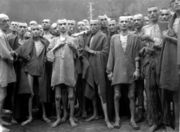
On February 19, 1942, Roosevelt signed Executive Order 9066, interning thousands of Japanese, Italians, German Americans, and some emigrants from Hawaii who fled after the bombing of Pearl Harbour for the duration of the war. 150,000 Japanese-Americans were interned by the U.S. and Canadian governments, as well as nearly 11,000 German and Italian residents of the U.S.
Allied use of slave labor occurred mainly in the east, such as in Poland , but more than a million was also put to work in the west. By December 1945 it was estimated by French authorities that 2,000 German prisoners were being killed or maimed each month in mine-clearing accidents.
Chemical and bacteriological weapons
Despite the international treaties and a resolution adopted by the League of Nations on 14 May 1938 condemning the use of toxic gas by Japan, the Imperial Japanese Army frequently used chemical weapons. Because of fears of retaliation, however, those weapons were never used against Westerners but only against other Asians judged "inferior" by the imperial propaganda. According to historians Yoshiaki Yoshimi and Seiya Matsuno, the authorization for the use of chemical weapons was given by specific orders (rinsanmei) issued by Hirohito himself. For example, the Emperor authorized the use of toxic gas on 375 separate occasions during the invasion of Wuhan, from August to October 1938.
The biological weapons were experimented on human beings by many units incorporated in the Japanese army, such as the infamous Unit 731, integrated by Imperial decree in the Kwantung army in 1936. Those weapons were mainly used in China and, according to some Japanese veterans, against Mongolians and Soviet soldiers in 1939 during the Nomonhan incident. According to documents found in the Australian national archives in 2004 by Yoshimi and Yuki Tanaka, cyanide gas was tested on Australian and Dutch prisoners in November 1944 in the Kai islands.
Bombings
Massive aerial bombing by both Axis and Allied air forces took the lives of hundreds of thousands of civilians. Anglo-American bombing of German cities claimed up to 600,000 civilian lives, most notably, the bombing of Dresden. The city of London was heavily bombed by the German Luftwaffe from September, 1940 to May, 1941 during their blitz of Britain; at one point the city was bombed for 57 straight nights. For the first, and so far only, time, nuclear weapons were used in combat: two atomic bombs released by the United States over Japan devastated Hiroshima and, three days later, Nagasaki. The number of total casualties in these bombings has been estimated at 200,000.
War trials
From 1945 to 1951, German and Japanese officials and personnel were prosecuted for war crimes. Charges included crimes against peace, crimes against humanity, waging wars of aggression, and other crimes. The most senior German officials were tried at the Nuremberg Trials, and many Japanese officials at the Tokyo War Crime Trial and other war crimes trials in the Asia-Pacific region. Many other minor officials were convicted in minor trials, including subsequent trials by the Nuremberg Tribunal, the Dachau Trials, and the Khabarovsk War Crime Trials.
